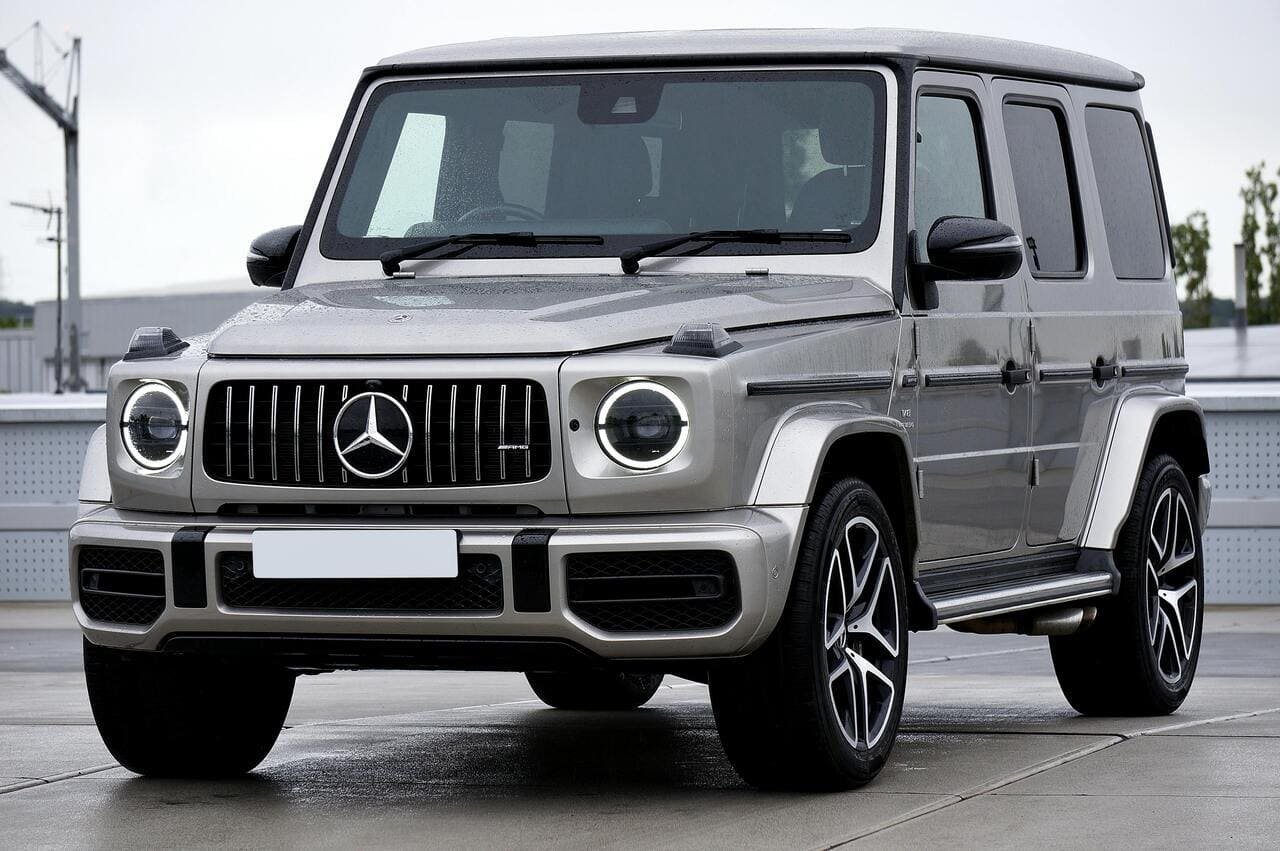When it comes to AMG, “reliable” isn’t usually the first word that comes to mind – these high-performance Mercedes are built for speed and thrills, often with complex engineering. However, a handful of AMG models (spanning older V8 sedans to brawny SUVs) have stood out for their durability and relatively trouble-free ownership. In this article, we’ll spotlight the top 5 most reliable Mercedes-AMG models (including both older and newer examples, sedans and SUVs). For each, we’ll cover key highlights (engine specs and performance), common issues/weak points, typical repair costs and maintenance needs, factors to consider before buying (problem areas to watch and parts availability), and how each stacks up against its competitors in reliability. Real owner feedback and reliability ratings from sources like Consumer Reports, J.D. Power, and enthusiast forums are included to back up the insights. Experienced car enthusiasts will appreciate the balanced, factual approach – professional in detail yet engaging in tone. Let’s dive into the AMG models that prove you can have both performance and dependability.
Top 5 Reliable Mercedes-AMG Models
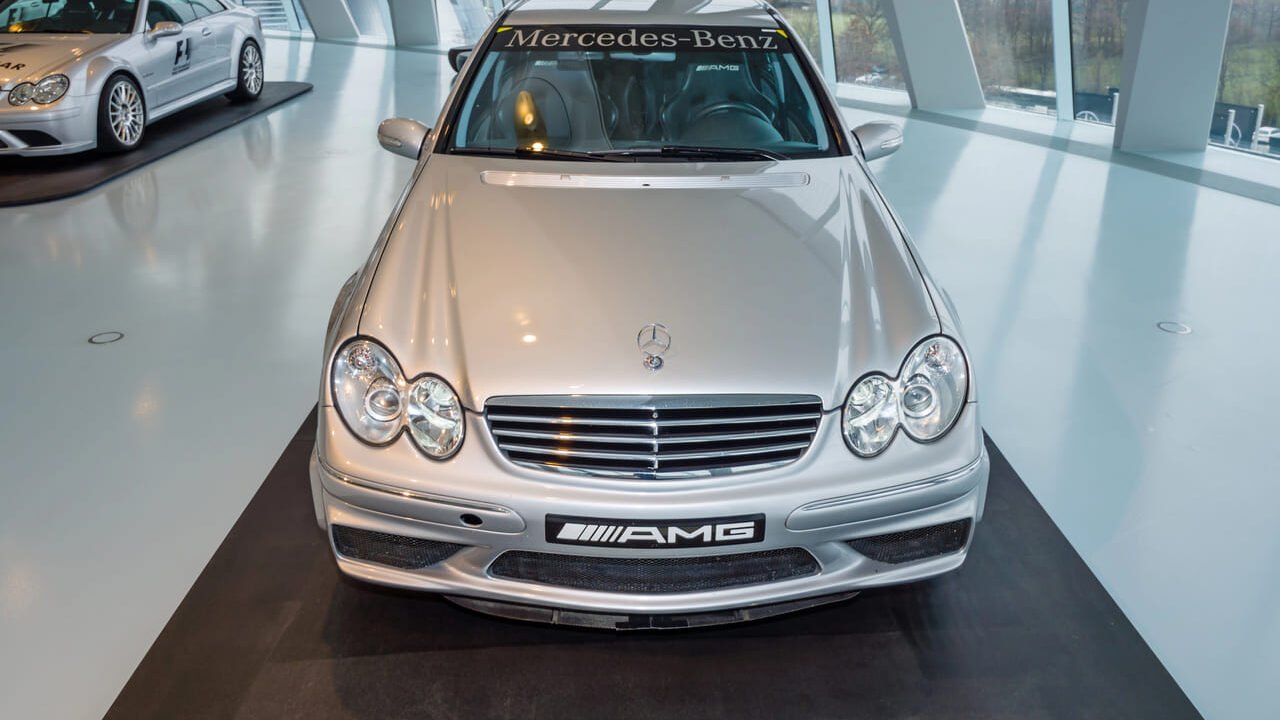
1. 2005–2006 Mercedes Benz C55 AMG (W203) – The Stout “Sleeper” Sedan
The C55 AMG is a compact executive sedan with a big heart. Stuffed into the W203 C Class chassis is a hand-built 5.4L naturally-aspirated V8 (M113) pumping out 362 hp and 376 lb·ft of torque. Power is sent to the rear wheels through the proven 5-speed 722.6 automatic. In a small sedan body, this gives the C55 AMG serious performance – 0–60 mph in the low 5-second range and effortless mid-range thrust.
Reliability highlights:
The C55 AMG is often cited as the most reliable AMG ever made by those in the know. Its naturally-aspirated V8 and conventional auto transmission are extremely tough. Aside from the occasional minor oil leak or sensor failure, there are few engine issues to worry about. The 5G-Tronic gearbox (722.6) is similarly stout and simpler than newer multispeed units.
Common issues & weak points:
No car is perfect, and the C55 AMG does have a few known weak spots to check:
- Engine oil leaks: Some M113 engines develop minor oil seepage from valve cover gaskets or the oil pan over time. These are generally minor and fixable with new gaskets.
- Accessory sensors: A crank position sensor or other engine sensor may fail occasionally, leading to a no-start or rough running until replaced. These sensors are not very costly.
- Suspension wear: The W203 chassis is robust, but things like control arm bushings and ball joints will wear with age (especially under the C55’s power). Listen for front-end clunks; refresh parts as needed.
- Interior and electronics: By now, some interior bits (seat motors, window regulators) or electronics (aging pixels in the cluster) could act up – typical 15+ year-old car ailments rather than C55-specific issues.
Notably, rust was a problem on early-2000s Mercedes, but the 2005–06 C Class benefitted from improved corrosion protection. Owners in forums rarely report serious rust on the C55, especially compared to older W210 E55s.
Maintenance costs:
One advantage of the C55’s parts commonality with other Mercedes is reasonable upkeep costs. The annual maintenance cost for a C55 AMG averages around $1,100–$1,200 per year, according to RepairPal data for similar AMG models. This is on par with or even slightly lower than some BMW M3s of the era. Regular servicing (oil changes, fluid flushes, brake pads) is straightforward. The suspension is a traditional shock/strut setup – no Adaptive Body Control or air springs. The big AMG brakes aren’t too expensive: pads and rotors on all four corners run about $500 total in parts, not far off regular C-Class brakes.
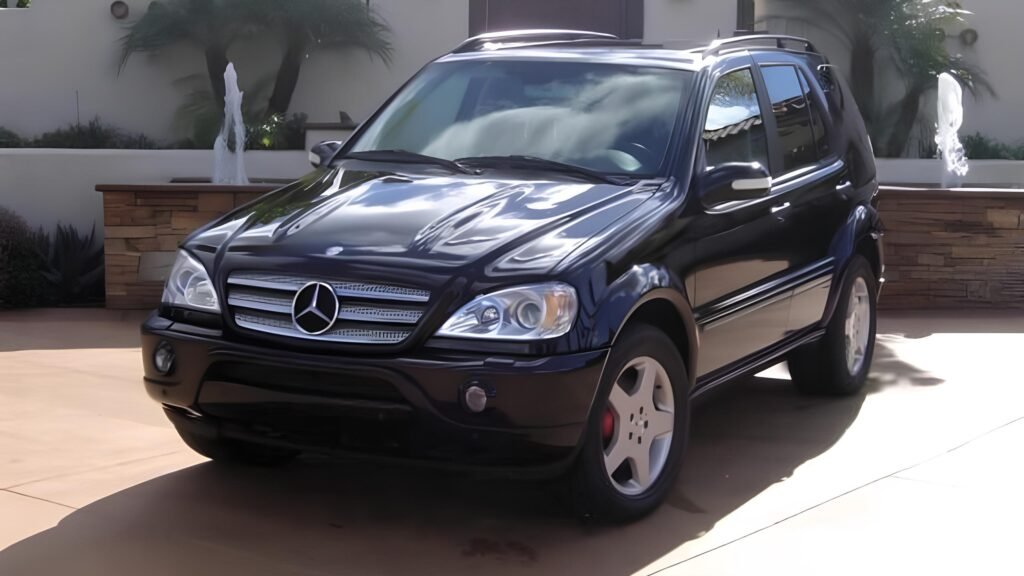
2. 2000–2003 Mercedes Benz ML55 AMG (W163) – Old-School SUV Muscle
Long before “AMG SUVs” became common, there was the ML55 AMG – a pioneering performance SUV. Based on the first-gen M-Class (W163). Under the hood lies the same 5.5L M113 naturally-aspirated V8 as the C55 (5,439 cc, single overhead cam, 24-valve), tuned for 342 hp and 376 lb·ft.
Reliability highlights:
The ML55 inherits the robust M113 V8 + 5G-Tronic transmission combo, which is a major reliability boon (as we saw with the C55). The ML55 does not have the air suspension that later AMG SUVs (like the ML63 or GLE63) use – it rides on standard springs/shocks.
Common issues & weak points:
The ML55 shares some foibles with the first-gen M-Class in general, plus a few AMG-specific notes:
- Brake wear: The brakes are large (8-piston front calipers) and the ML55 is heavy, so it tends to eat brake pads and rotors relatively quickly. Expect to replace pads more often than on a normal car (perhaps every ~20k miles).
- Front suspension and steering: Ball joints and control arm bushings are known wear items on W163s, and the ML55’s harder use can accelerate this. If you hear clunks or see uneven tire wear, budget for a front-end rebuild. Parts are readily available. The steering rack can develop leaks on high-mileage trucks – watch the power steering fluid level.
- Rear suspension springs: The ML uses coil springs in rear, and on ML55 these have been known to sag or crack over time, especially if the vehicle towed frequently. Replacing springs (or upgrading to slightly stiffer aftermarket ones) resolves any droop.
- Fuel pump: A known weak point on some older W163s (including ML55) is the fuel pump failing, which can cause stalling or no-start. Fortunately, it’s a relatively simple fix (access under rear seat) and not too expensive.
- Interior build: Early M-Classes had some interior trim and build-quality issues (rattles, bits of plastic trim that can break). The AMG doesn’t really fix that but it’s more of a nuisance than a reliability issue.
Do note that by now (20+ years old), any untended maintenance can become an issue – e.g. neglected cooling system (hoses, radiator) or old spark plugs can cause trouble – so find one that’s been kept up.
Maintenance costs:
When new, the ML55 AMG carried a hefty price tag, but today it can be run on a fairly modest budget (especially if you do some work yourself). Common maintenance parts – brakes, suspension bits, filters, fluids – cross over with the standard ML430/ML500. The annual repair/maintenance cost on an ML55 is roughly in line with other luxury SUVs of its era – expect around $1,000–$1,200 per year on average, according to owner-reported data (some years less, some more).
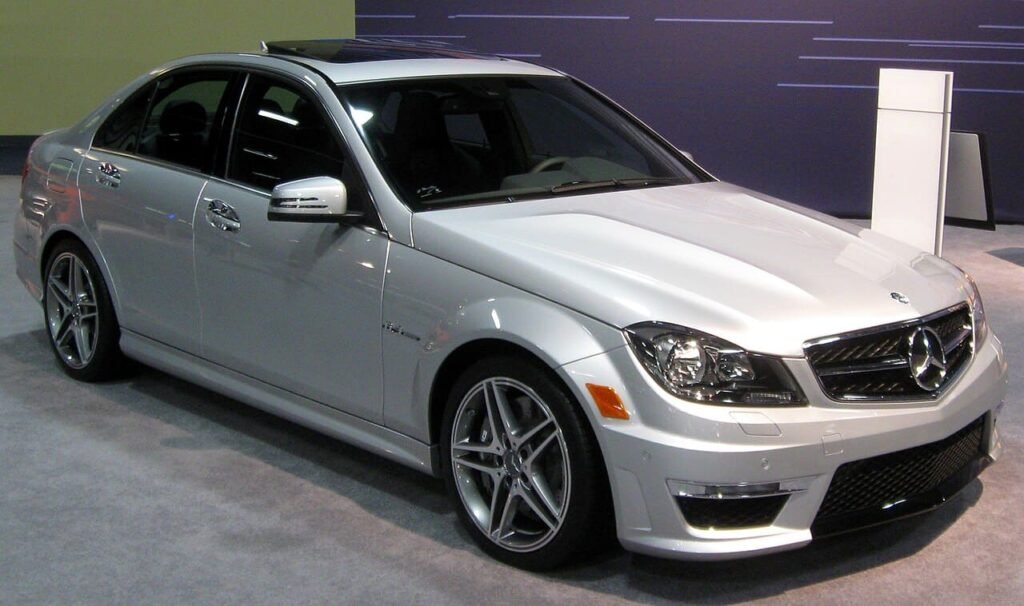
3. 2008–2015 Mercedes Benz C63 AMG (W204) – The “Hammer” C-Class with a Reliable Bite
If any AMG model has achieved legend status, it’s the C63 AMG. Introduced in the W204 generation (for 2008 in sedan form, later as a coupe), the C63 took the compact C-Class and turned the dial up to 11 with a monstrous 6.2L naturally-aspirated V8 (M156) that produces 451 hp and 443 lb·ft.
Reliability highlights:
The C63’s M156 V8 is quite robust. The engine’s bottom end and internals are very strong; many have been supercharged or tracked hard without issue. The 7-speed automatic (Speedshift 7G-Tronic, later a MCT version) is also durable if serviced. the Mercedes C-Class (which includes the C63) scored above-average reliability in some J.D. Power surveys (e.g. an 81/100 “Great” quality & reliability score in 2021 for the C-Class).
Common issues & weak points:
Early W204 C63s did have a couple of well-known issues, most notably the head bolt problem:
- Head bolts (2008–2010 models): The initial M156 engines had head bolts prone to corrosion and failure, which could lead to a head gasket leak. This typically showed up as misfires or coolant loss in higher-mileage early cars. Mercedes revised the bolt material in mid-2011.
- Camshaft adjusters & lifters: Some M156 engines have experienced camshaft lifter (tappet) wear or cam adjuster solenoid issues around 60k+.
- Valve cover oil leaks: Like many engines, the M156 can develop oil leaks from valve cover gaskets or the oil filter housing over time.
- Thermostat & cooling hoses: Around ~80k+ miles, some owners report needing to replace the thermostat or an occasional coolant hose that cracked.
- Suspension & differential bushings: The C63’s suspension is generally reliable, but hard driving will wear the rear differential bushings and engine/trans mounts.
- Tires & brakes (consumables): A weak point only in the sense that the C63 AMG loves to devour them! Rear tires, especially, can wear quickly if you enjoy the throttle. Brake pads/rotors likewise wear faster with spirited use.
Notably, no chronic electrical or HVAC issues appear frequently in owner reports – the W204 platform electronics were relatively sorted.
Maintenance costs:
The C63 AMG is more expensive to maintain than a regular C-Class – there’s no denying that. 16 spark plugs (two per cylinder) that are costly to replace every ~50k miles, and high-performance brakes/tires. Third-party data shows an annual maintenance/repair cost around $1,100–$1,200 for the C63. An oil change costs ($210), transmission service ($600), diff service ($250), new rear brake pads ($62), and two tires ($505) right off the bat. The transmission service at 40k or 60k costs around $400-$600. Brake jobs (pads/rotors) could run $1,000+ at a shop, but intervals depend on use (maybe every 20-30k miles with street driving).
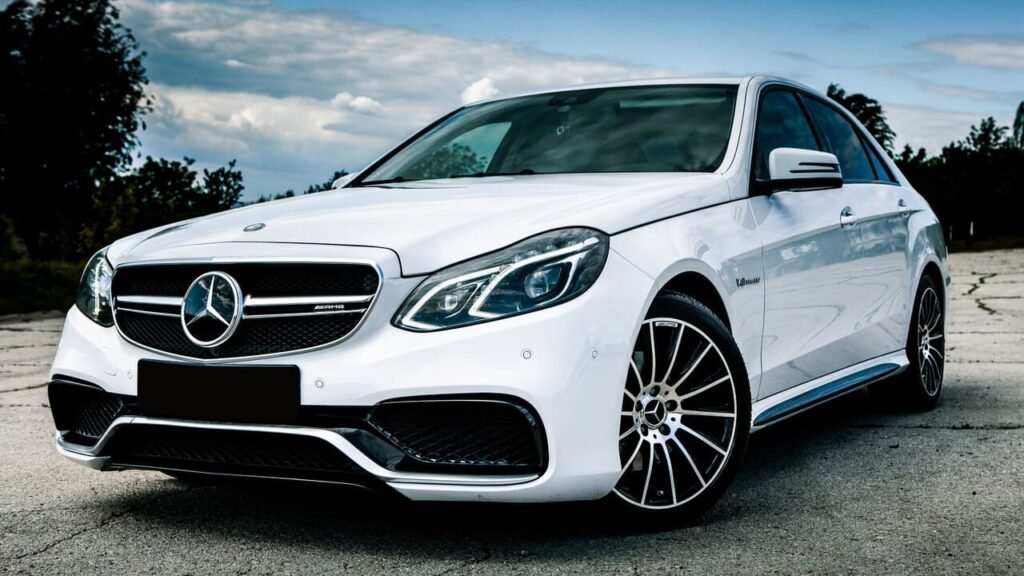
4. 2012–2016 Mercedes Benz E63 AMG (W212) – Midsize Luxury with Bulletproof Biturbo Power
For those seeking a blend of high performance and business-class luxury, the W212 E63 AMG is a top contender – and it’s proven to be one of the more dependable modern AMG sedans. The E63 launched in 2010 with the 6.2L NA V8, but notably switched in 2012 to the 5.5L twin-turbo V8 (M157). It’s the 2012–2016 models (both pre- and post-facelift) that we’ll focus on, as they benefit from the refined M157 biturbo engine, known for stout reliability and immense torque. In standard form the 5.5L puts out 518 hp and 516 lb·ft, while the later S-Model (and 2014 refresh) cranked to 550–577 hp and up to 590 lb·ft.
Reliability highlights:
The E63 AMG (2012+) benefits from some key engineering choices that enhance reliability: the M157 V8 is based on the robust architecture of the M278 (used in millions of regular Mercedes), scaled up for AMG. It has lower specific output than the old 6.2 (making 550 hp with two turbos is relatively unstressed compared to 510 hp naturally aspirated from 6.2L). The W212’s electronics were also praised for being more reliable than the preceding generation. In Consumer Reports data, the 2012–2015 E-Class (all trims) showed average or better reliability in most categories, and J.D. Power gave these model years solid predicted reliability scores (around 81/100 “Great” for quality & reliability). Overall, the consensus is that the W212 E63 has durability befitting an E-Class, despite its outrageous performance.
Common issues & weak points:
While generally reliable, there are a few items E63 owners have encountered:
- Air suspension (if equipped): Rear air springs on the wagon (and some sedan options) can eventually leak as they age (8-10+ years). One owner noted an “air bladder leak” in a rear shock around 9 years old – not unexpected. The fix is replacing the rear air bags (aftermarket Arnott replacements are ~$500 each and more durable).
- Cooling system: A few owners reported minor cooling system repairs – for example, a cracked coolant hose around 60–70k miles, or a leaking reservoir.
- Suspension & bushings: With hard use, the front control arm bushings and other suspension links can wear (one owner needed a front control arm bushing at ~75k). Also, the E63S with dynamic engine mounts – those mounts can wear out and leak fluid over time.
- Engine and turbos: The M157 has been quite reliable. Some early units (2012) had camshaft adjuster solenoid issues – if one fails, it can cause a check-engine light. Mercedes released updated solenoids; most cars were fixed under warranty. Turbochargers on the M157 generally last long, especially if oil changes are regular. There was an oil feed line to turbo recall on some 2012–2014 models where a leak could develop – ensure that recall was performed (dealers replaced the turbo oil lines).
- Electronics: The W212’s electronics are mature. A failing ignition coil or sensor can happen but isn’t especially common. The COMAND infotainment might feel dated but isn’t particularly failure-prone. Ensure the back-up camera (if equipped) works and that all gauges read correctly (some 2014 had an electronic gauge cluster – rarely, software updates are needed).
Maintenance costs:
Maintaining an E63 AMG is similar to the C63 in many respects – the engine is larger and twin-turbo, but intervals are analogous. Yearly maintenance might average $1,200–$1,500. Oil changes (every 5k-7k miles) are crucial for the turbos’ longevity; expect ~$150 per change. The spark plugs (16 of them) should be changed ~ every 60k – that’s a few hundred dollars in parts and a few hours labor. The 7-speed transmission and the 4Matic transfer case both need fluid changes around 40k (budget ~$800 total for a full driveline service). Brake jobs on the E63S with composite rotors or (optional) carbon-ceramics can be very expensive – e.g. carbon ceramic rotors can cost $5k+ for a set, so verify if the car has standard steel brakes or ceramics. Most Mercedes-Benz E63 AMG owners stick to steel brakes for this reason. Tires on 19” or 20” AMG wheels will run $1,200+ for a set of high-performance rubber, likely every 15k-20k miles depending on driving. One specific big-ticket item: if equipped with the optional carbon ceramic front brakes (rare on E63), replacing those rotors at end of life is around $8–10k – so many avoid or swap to steel rotors when the time comes.

5. 2013–2018 Mercedes Benz G63 AMG (W463) – Iconic G-Wagen Ruggedness Meets AMG Power
Rounding out the list is a vehicle that embodies brute-force engineering: the Mercedes G63 AMG. The G-Class (or “G-Wagen”) has military truck roots dating back to the 1970s, and the G63 (introduced for 2013) injected modern AMG muscle into that classic platform. Under the hood lies the same 5.5L twin-turbo V8 (M157) with 536 hp and 560 lb·ft, coupled to a stout 7-speed auto and full-time 4WD with locking differentials.
Reliability highlights:
The G63’s W463 chassis is legendary for enduring abuse – it has a ladder frame, solid front and rear axles, and three fully locking differentials. There are no air springs, no adaptive dampers – just heavy-duty coils and gas shocks. Electrically, the Mercedes G63 is simpler than most modern Benzes: it has traction and stability control but not the complex network of systems you’d find in an S-Class. The M157 engine in the G63 is actually slightly detuned compared to an E63 (536 hp vs 550+ in sedans). The transmission (7G-Tronic) is calibrated for torque and longevity. Also, the G’s interior, while luxurious, doesn’t have the complicated newer infotainment of other 2013+ Mercs – a simpler COMAND unit is used, reducing chances of tech failure.
Common issues & weak points:
The G63 does have a few things to keep an eye on, largely due to the aging platform:
- Suspension wear: The solid axles mean lots of linkage and bushing points. Over time (especially if the vehicle is driven off-road or on poor roads), things like pan-hard rod bushings, control arm bushings, and wheel bearings can wear out.
- Steering components: The recirculating-ball steering box can develop a bit of play after many miles – adjustable to a degree, or rebuildable if needed. Tie rod ends and drag link ends will eventually need renewal.
- Brake consumption: The G63 AMG, being heavy and powerful, goes through brake pads relatively quickly. Fortunately, the brakes are large and derived from commercial-grade parts, so warping rotors isn’t common.
- Exhaust and mounts: The side-exit exhausts on the Mercedes G63 AMG can occasionally loosen brackets or develop minor leaks at joints due to vibration. Additionally, the engine and transmission mounts might wear faster because the heavy engine and body-on-frame allow more movement.
- Electrical quirks: The G-Class had some quirks – for instance, older models experienced issues with window regulators and door lock actuators. By 2013 these were improved, but one might still find a slow window or a door lock that needs a second press occasionally. The backup camera on early 2013 models is a bit small/resolution-poor, but not a reliability issue per se.
The M157 engine itself in the Mercdes-Benz G63 AMG is in a mild state of tune, so it generally doesn’t stress anything. The G’s cooling system is robust (designed for climbing dunes in Dubai), so overheating is rare unless a fan fails (and even that would throw a warning quickly). The transmission might require a conductor plate service eventually (like any 7G), but that’s well-known territory for Mercedes shops.
Maintenance costs:
On a yearly basis, plan for around $1,200–$1,500 in maintenance, similar to the E63 on which it’s based (though fuel and tire costs will be higher due to weight). Oil changes are big (~9 quarts) but typically once a year if low miles. The 4WD system (transfer case and 3 diffs) has multiple fluids that Mercedes recommends changing periodically (transfer case every ~50k, diffs similar). The spark plugs on the M157 should be changed about every 4 years or 40k – that’s 16 plugs, maybe ~$500 job at a shop. Brake pads for the G63 are a regular item – a full set of pads installed might be ~$800-$1000. Tires (large 20” all-season or performance tires) can run $300 each.
Top 5 AMG Models vs. Competitors
To put these models in context, below is a comparison of their reliability aspects against key competitors:
| AMG Model (Years) | Key Reliability Strengths | Main Competitors (Similar Era) | Competitor Reliability Notes |
|---|---|---|---|
| C55 AMG (2005–2006) | Robust M113 5.4L NA V8 & 5G-Tronic auto (very durable). No air suspension or turbos to fail. Simple, proven chassis design. Owners report minimal issues beyond small leaks. | BMW M3 (E46, 2001–06); Audi S4 (B6/B7, 2003–08) | BMW E46 M3: High-strung I6 had rod bearing recall and VANOS issues; overall reliable but more fragile engine than C55’s bulletproof V8. Audi S4: 4.2L V8 had common timing chain tensioner failures requiring engine-out repair – a major expense. |
| ML55 AMG (2000–2003) | Sturdy body-on-frame SUV build. M113 5.5L NA V8 shared with C/E55 (bulletproof). Simplified tech (no adaptive suspension). Inexpensive fixes for common wear parts. | BMW X5 4.6is (E53, 2002–03); Porsche Cayenne Turbo (955, 2004–06) | BMW X5 4.6is: Strong performance, but early X5s had cooling system failures, electrical gremlins, and some air suspension issues. Porsche Cayenne Turbo: Much faster but notorious for costly issues (coolant pipe leaks, cardan shaft failures, air suspension leaks). |
| C63 AMG (W204, 2008–2015) | Stout M156 6.2L V8. No forced induction or ABC. Generally solid transmission and electronics. | BMW M3 (E90, 2008–13); Audi RS5 (2013–15) | BMW E90 M3: Fabulous NA V8, but plagued by rod bearing wear and throttle actuator failures (~$3-5k fixes) – issues the C63 doesn’t face. Audi RS5: Reliable engine, but direct-injection carbon buildup and dual-clutch transmission maintenance make it more maintenance-intensive. |
| E63 AMG (W212, 2012–2016) | Well-proven M157 5.5L biturbo V8 (lower stress per hp) – very few engine faults. Solid 7-speed and 4Matic AWD (post-2013) improves durability. Minor issues only (e.g. occasional hose leak). | BMW M5 (F10, 2012–16); Audi RS6/RS7 (C7, 2013–18) | BMW F10 M5: Twin-turbo V8 has had injector and oil pump issues; the DCT gearbox can be troublesome. Maintenance is high (e.g. frequent spark plug swaps). Audi RS7: Blistering performance but known for turbo problems (oil screen clogs) and expensive repairs. The E63’s powertrain is often considered more robust long-term. |
| G63 AMG (W463, 2013–2018) | Rugged G-Class construction – solid axles, body-on-frame – built for longevity. Detuned M157 V8 (536 hp). Simpler suspension (coil springs) and proven 4WD system. Few high-tech failure points despite luxury amenities. | Range Rover Sport SVR (2014–17); Bentley Bentayga (2017+); Lamborghini Urus (2018+) | Range Rover SVR: Supercharged V8 sounds great, but Land Rover reliability is notorious – frequent electronic and suspension faults. Bentley/Urus: Ultra-fast, but very complex and low-volume – long-term reliability unknown, likely expensive to maintain. |
Buyer’s Tips:
Each of these top 5 AMG models proves that with the right engineering (and a bit of owner diligence), an AMG can deliver thrilling performance without becoming a reliability nightmare. The common threads among these models are robust, well-tested powertrains and avoiding unnecessary complexity. The M113 and M157 V8s in particular shine as durable engines when maintained – many of the models above use them, and they’ve earned a solid reputation. Prospective buyers should take away a few actionable insights:
- Prioritize Maintenance History: No matter how inherently reliable a model is, a neglected AMG can quickly become problematic. Look for cars with documented oil changes, timely fluid swaps, and cared-for consumables. A fully serviced C63 or E63 will almost always be a safer bet than a mystery-history cream puff. For older models (C55, ML55), confirmation of basic upkeep (fluids, belts, bushings) and any rust repair is key. For newer ones (C63, E63, G63), evidence that known issues (e.g. C63 head bolts, E63 recall campaigns) were addressed is valuable. Buy on condition and history, not just mileage.
- Be Aware of Known Weak Points: As outlined, each model has a couple things to watch. If you’re eyeing a pre-2012 C63, verify the head bolts were updated. For an E63 with rear air suspension, check those air springs or consider a warranty that covers them. For a G63, be prepared for its appetites (fuel, brakes, tires) and ensure the 4WD bits work (many owners forget to test the diff locks). Knowing these quirks means you can negotiate price or plan future fixes accordingly. None of these issues are deal-breakers – but addressing them promptly prevents bigger problems down the road.
- Use Specialist Independent Shops: Especially as these AMGs age out of warranty, find a reputable independent Mercedes/AMG specialist for maintenance. They often charge less than dealers and know the common failure points. For example, an indie shop can replace C63 head bolts or E63 cam solenoids at a fraction of dealer cost, using updated parts. Enthusiast forums are a great resource to locate trustworthy mechanics in your area who have experience with these specific models. This approach keeps ownership costs reasonable and reliability high, as issues are fixed correctly the first time.
- Budget for Maintenance & Enjoy the Drive: Prospective buyers should set realistic expectations – these are still high-performance machines, so maintenance will cost more than a Camry. When you keep on top of maintenance, you’ll find that these AMGs can be daily-driven reliably. Many owners do just that, racking up miles with smiles. For instance, it’s not unusual to see a well-kept E63 or C63 with 100k+ miles still going strong and being praised by its owner.
Final Verdict: Which AMG Should You Buy?
The top 5 AMG models we’ve covered – the C55, ML55, C63, E63 (W212), and G63 – each strike a desirable balance of performance and dependability. They demonstrate that “AMG” and “reliability” need not be mutually exclusive terms. By selecting a model that fits your needs (sport sedan vs SUV, older V8 charm vs newer tech) and following the guidelines above, you can own a thrilling Mercedes-AMG with confidence. These cars reward attentive owners with years of explosive acceleration, sonorous exhaust notes, and grin-inducing drives – all without frequent trips to the mechanic. Do your homework, invest in a good example, maintain it well, and you’ll join the ranks of AMG enthusiasts who proudly daily-drive these machines year after year. In other words, find the right AMG, take care of it, and it will take care of you – on the road and at the track, rather than in the shop.
In the end owning an AMG really pays off if you keep up with maintenance. Pick the right one and you could enjoy some amazing drives for a long time.
if you’re a fan of Mercedes-Benz, you should definitely check this out:
Is the Mercedes-Benz C63 AMG a Reliable Performance Sedan?.
And while you’re hanging around, don’t forget to look at other parts of our site. We’ve got thorough car reviews, handy buying tips, and the newest news from the industry all set for you. So take a look and be sure to bookmark our homepage for all the future updates!

